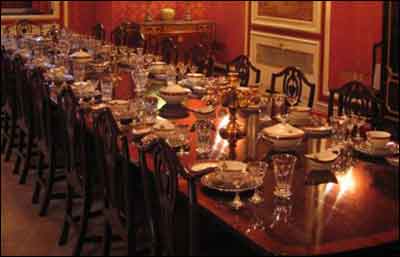Most people don't know anything about planning. Sure, they may understand the general gist of it, but many planning concepts just haven't yet made it into the public consciousness. In an effort to accelerate the education of the public, here's an easy-to-use pictorial guide that relates some of those not-so-familiar planning concepts to something we're all familiar with: food.
Most people don't know anything about planning. Sure, they may understand the general gist of it, but many planning concepts just haven't yet made it into the public consciousness. In an effort to accelerate the education of the public, here's an easy-to-use pictorial guide that relates some of those not-so-familiar planning concepts to something we're all familiar with: food.
Here's a few examples of some planning concepts made more accessible through food-based analogies.
General Plan - The basic framework for making and maintaining a city.

Zoning - The land-use regulations that dictate which uses go where. Often creates a separation between development types.

Mixed Use Development - Integration of different land use types in the same area.

High Density - The concentration of more people, developments and land uses in smaller areas.

Eminent Domain - The taking of private land by the government for the benefit of the community.

Sprawl - Expansive development beyond the urban fringe, occupying huge amounts of land.

Adaptive Reuse - The redevelopment of an area or a property into a new land use type for which it was not originally intended.

Infrastructure (Ideal) - The backbone of cities, consisting of essential services such as water piping, sewage disposal, energy transmission, roads and transit, and other core services that operate efficiently and in a well-maintained fashion.

Infrastructure (Actual) - The real state of the city's essential services: undermaintained, insufficient and out of date.

Blight - Properties of degraded or lower physical qualities that bring down the quality of the immediate surrounds.

Infill Development - New development built to replace underperforming or abandoned properties in existing high density urban areas.

Affordable Housing (Projects Style) - Large, high density public housing projects offering low- and no-frills affordable housing in dense urban areas.

Affordable Housing (Modern Style) -
Architecturally-experimental housing built for low-income residents -- often in garish and gaudy colors -- meant to help the low-income better fit in with their neighbors and to downplay the stigma associated with public housing.

McMansion - A grossly oversized home.

High Rise Buildings - Tall or skyscraping buildings typically found in dense urban areas and central business districts.

Historic Preservation - The practice of identifying, renovating, and preserving properties and places of historic value.

Transit Oriented Development - Development that is located adjacent or near to public transportation lines and stations.

Garden City - Master-planned communities surrounded by greenbelts that were part of the late-18th Century Garden City Movement founded by Ebenezer Howard.

Design Charrette - A participatory planning exericse that brings community members and design professionals together to collaborate on city design.

Form-Based Codes - Guidelines that regulate the aesthetic features of new developments.

Dedicated Lanes - Street lanes that are set aside from car traffic for exclusive use by modes such as bus rapid transit or bicycles.

Green Roofs - Integration of organic and living substances on the roofs of buildings.

Tax Incentives - Perks and tax breaks provided by cities to developers based on the prediction that whatever they develop will generate an economic benefit to the city greater than what was provided as the incentive.

--
OK, well some of those were a little bit of a stretch, but the basic principles are there. In fact, they're all around. So if you're having trouble wrapping a non-planner's noggin around some obscure concepts, skip the jargon and open your fridge.
All images courtesy Wikimedia Commons (except General Plan by Flickr user Nate Steiner, and McMansion by Flickr user Russell).

Planetizen Federal Action Tracker
A weekly monitor of how Trump’s orders and actions are impacting planners and planning in America.

Maui's Vacation Rental Debate Turns Ugly
Verbal attacks, misinformation campaigns and fistfights plague a high-stakes debate to convert thousands of vacation rentals into long-term housing.

San Francisco Suspends Traffic Calming Amidst Record Deaths
Citing “a challenging fiscal landscape,” the city will cease the program on the heels of 42 traffic deaths, including 24 pedestrians.

Defunct Pittsburgh Power Plant to Become Residential Tower
A decommissioned steam heat plant will be redeveloped into almost 100 affordable housing units.

Trump Prompts Restructuring of Transportation Research Board in “Unprecedented Overreach”
The TRB has eliminated more than half of its committees including those focused on climate, equity, and cities.

Amtrak Rolls Out New Orleans to Alabama “Mardi Gras” Train
The new service will operate morning and evening departures between Mobile and New Orleans.
Urban Design for Planners 1: Software Tools
This six-course series explores essential urban design concepts using open source software and equips planners with the tools they need to participate fully in the urban design process.
Planning for Universal Design
Learn the tools for implementing Universal Design in planning regulations.
Heyer Gruel & Associates PA
JM Goldson LLC
Custer County Colorado
City of Camden Redevelopment Agency
City of Astoria
Transportation Research & Education Center (TREC) at Portland State University
Jefferson Parish Government
Camden Redevelopment Agency
City of Claremont


























